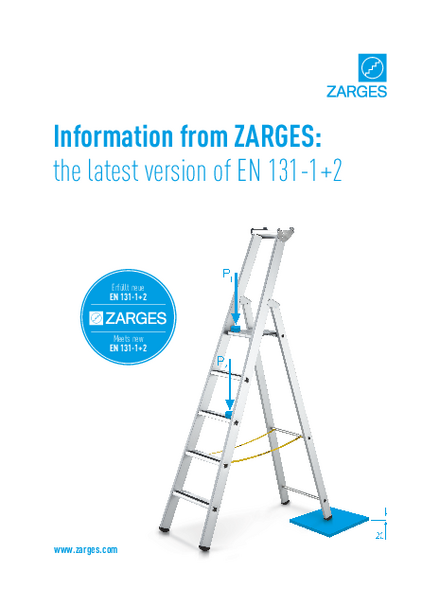Reliable safety EN 131 – the most important improvements.
EN 131-1+2*, the standard that applies to ladders, was comprehensively revised. The newly revised standard will come into effect throughout Europe at the latest by the end of 2017. Here we provide you with an overview of the individual tests required by the new standard as well as the most important improvements aimed at further enhancing safety when working with ladders. Please take note that a few features may no longer be available or only be partially available as a result of the new European standard for ladders.
Your benefits – always standard-compliant with ZARGES
- Stay on the safe side legally
ZARGES ladders meet the requirements of all relevant product standard and offer market leading performance. They meet the standard for “Professional” class. In this way you can be sure that ZARGES ladders are as professional as you are, regardless of whether in skilled trades, the industry or a household setting. - Work safely
The new, more stringent tests have shown: that the standard-compliant ZARGES ladders are highly stable and slip-resistant. This helps you avoid risks, reduce accidents as much as possible, and minimise loss of working hours. - Fulfilling requirements throughout Europe
The new version of EN 131-1+2 is applicable throughout Europe. Regardless of where you are active in Europe: ZARGES ladders fulfil with the requirements of the standards in the whole of Europe. - One-off investment, long-term benefits
ZARGES ladders are even more robust and durable thanks to the new, more stringent tests set out in the revised standard. That is why when you buy a ZARGES ladder, you are investing in not only safety, but also a piece of access equipment that will accompany you for a very long time.
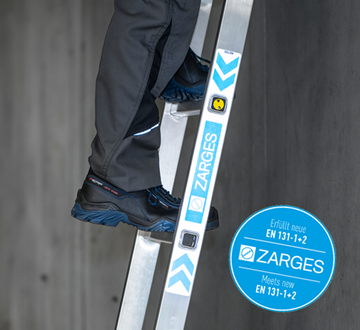
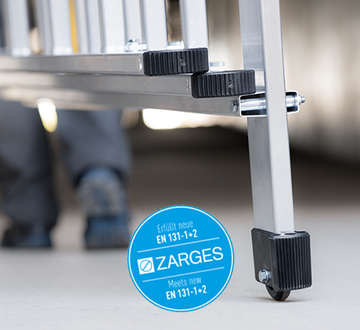
EN 131-1+2 – what has changed?
- Classification “Professional” & “Non-professional”: In future, ladders will be classified into two categories. The “Professional” category is for ladders that are intended for use in a professional setting. Ladders that are meant for household use are categorised as “Non-professional”. All ZARGES ladders are classified as “Professional” without exception.
- More stringent tests – more robust ladders: Additional tests as well as stricter tests bring ladders to their limits. But not ZARGES ladders. Ladders by ZARGES pass all these tests with flying colours.
- Wider base: All ladders 3,000 mm or longer that can be used as a leaning ladder are required to have a base stabiliser. Safer and more stable standing for a wide range of tasks.
IMPORTANT: For push-up ladders that are longer than 3,000 mm when retracted, the individual ladder parts are no longer allowed to be used separately because of this new requirement. For multipurpose ladders that are longer than 3,000 mm when retracted, the upper ladder can no longer be used separately; such ladders are also no longer allowed to be used on stairs.
FAQs on EN 131-1+2
What’s new in EN 131-2? How is it tested?

Requirement “Torsion Stepladder”
What is tested:
- Torsional stiffness
How is it tested:
- One of the ladder feet is secured using a clamp.
- A load of 736 N is applied to the ladder platform.
- Subsequently, a lateral pulling force of 137 N is applied to the ladder.
The requirement:
- When the test load is being applied, the other ladder foot should not move more than 25 mm from its original position.

Requirement “Continuous Stress”
What is tested:
- Durability of the ladder
How is it tested:
- A load of 1,500 N is applied alternately between the topmost step/rung and the middle step/rung of the ladder
- Repetitions for “non-professional”: 10,000 cycles
- Repetitions for “professional”: 50,000 cycles
The requirement:
- There should be no damage to the ladder.

Requirement “Base Slip”
What is tested:
- Slip-resistance of the ladder end caps.
How is it tested:
- The ladder is placed standing on a glass panel.
- The ladder is subject to a concentric load of 1,471 N.
- The load is applied 4 times to the ladder.
The requirement:
- The feet of the ladder should not slide more than 40 mm within 1 minute.

Requirement “Torsion Leaning Ladders”
What is tested:
- Torsional stiffness
How is it tested:
- The first step involves applying a concentric load of 491 N to the ladder for 30 seconds. This is done to determine the initial value.
- In the next step, a concentric load of 638 N is applied to one of the stiles and the deformation of both stiles are measured relative to the initial value.
The requirement:
- The difference between the deformation of the two stiles should not exceed 0.07 times of the ladder width.
An overview of the new requirements and tests according to DIN EN 131-1+2
Safety first: According to the latest version of the EN 131-1+2 standard, ladders are required to fulfil additional as well as stricter requirements. You can read about the new or stricter tests in the overview.
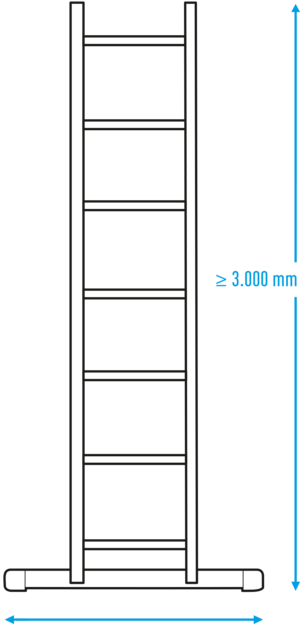
Requirement “Base Stabiliser”
The new requirement:
- All ladders 3,000 mm or longer that can be used as a leaning ladder are required by the new standard to have a base stabiliser.
- The required width of the base stabiliser may be up to 1,200 mm, depending on the length of the ladder.
Note!
Because of this new requirement, a few features are no longer available for multi-part ladders:
- For push-up ladders that are longer than 3,000 mm when retracted, the ladder parts are no longer allowed to be used separately.
- For multipurpose ladders that are longer than 3,000 mm when retracted, the upper ladder can no longer be used separately; such ladders are also no longer allowed to be used on stairs.
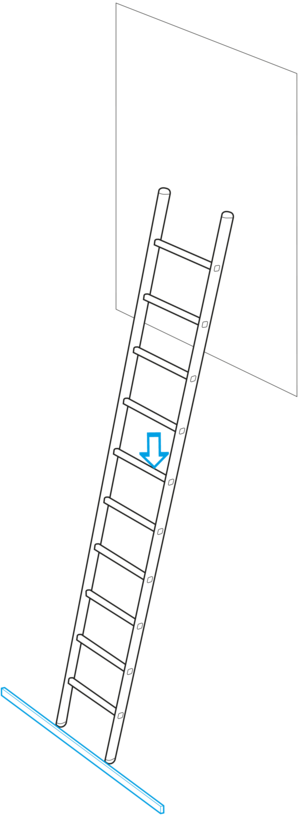
Requirement “Stile Strength”
What is tested:
- The strength of the stiles
How is it tested:
- The step/rung is subject to an eccentric test load of 2,700 N (for the “Professional” category)
or 2,250 N (for the “Non-professional” category) in its usual use position.
The requirement:
- The ladder must not be damaged and must retain its functionality.
ZARGES – safety is our standard
The philosophy of ZARGES: Safety first. This is why ladders made by ZARGES today comply with current national and international standards. And our certified development and manufacturing processes are guaranteed to give you safety and the highest reliability.
You can find more information on our quality standards and other important topics relating to the safety of our ladders by clicking on the following links:
Download information brochure
Do you have any questions concerning our products or the changes to the standards?
You can get in touch with our service team by
Phone: +49 881 687-100
E-mail: vertrieb@zarges.de
or simply use our contact form
